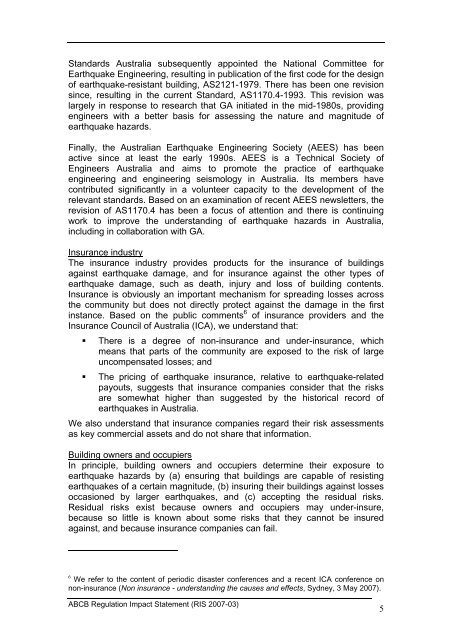PDF | 2 MB - Australian Building Codes Board
PDF | 2 MB - Australian Building Codes Board
PDF | 2 MB - Australian Building Codes Board
You also want an ePaper? Increase the reach of your titles
YUMPU automatically turns print PDFs into web optimized ePapers that Google loves.
Standards Australia subsequently appointed the National Committee for<br />
Earthquake Engineering, resulting in publication of the first code for the design<br />
of earthquake-resistant building, AS2121-1979. There has been one revision<br />
since, resulting in the current Standard, AS1170.4-1993. This revision was<br />
largely in response to research that GA initiated in the mid-1980s, providing<br />
engineers with a better basis for assessing the nature and magnitude of<br />
earthquake hazards.<br />
Finally, the <strong>Australian</strong> Earthquake Engineering Society (AEES) has been<br />
active since at least the early 1990s. AEES is a Technical Society of<br />
Engineers Australia and aims to promote the practice of earthquake<br />
engineering and engineering seismology in Australia. Its members have<br />
contributed significantly in a volunteer capacity to the development of the<br />
relevant standards. Based on an examination of recent AEES newsletters, the<br />
revision of AS1170.4 has been a focus of attention and there is continuing<br />
work to improve the understanding of earthquake hazards in Australia,<br />
including in collaboration with GA.<br />
Insurance industry<br />
The insurance industry provides products for the insurance of buildings<br />
against earthquake damage, and for insurance against the other types of<br />
earthquake damage, such as death, injury and loss of building contents.<br />
Insurance is obviously an important mechanism for spreading losses across<br />
the community but does not directly protect against the damage in the first<br />
instance. Based on the public comments 6 of insurance providers and the<br />
Insurance Council of Australia (ICA), we understand that:<br />
• There is a degree of non-insurance and under-insurance, which<br />
means that parts of the community are exposed to the risk of large<br />
uncompensated losses; and<br />
• The pricing of earthquake insurance, relative to earthquake-related<br />
payouts, suggests that insurance companies consider that the risks<br />
are somewhat higher than suggested by the historical record of<br />
earthquakes in Australia.<br />
We also understand that insurance companies regard their risk assessments<br />
as key commercial assets and do not share that information.<br />
<strong>Building</strong> owners and occupiers<br />
In principle, building owners and occupiers determine their exposure to<br />
earthquake hazards by (a) ensuring that buildings are capable of resisting<br />
earthquakes of a certain magnitude, (b) insuring their buildings against losses<br />
occasioned by larger earthquakes, and (c) accepting the residual risks.<br />
Residual risks exist because owners and occupiers may under-insure,<br />
because so little is known about some risks that they cannot be insured<br />
against, and because insurance companies can fail.<br />
6<br />
We refer to the content of periodic disaster conferences and a recent ICA conference on<br />
non-insurance (Non insurance - understanding the causes and effects, Sydney, 3 May 2007).<br />
ABCB Regulation Impact Statement (RIS 2007-03)<br />
5
















